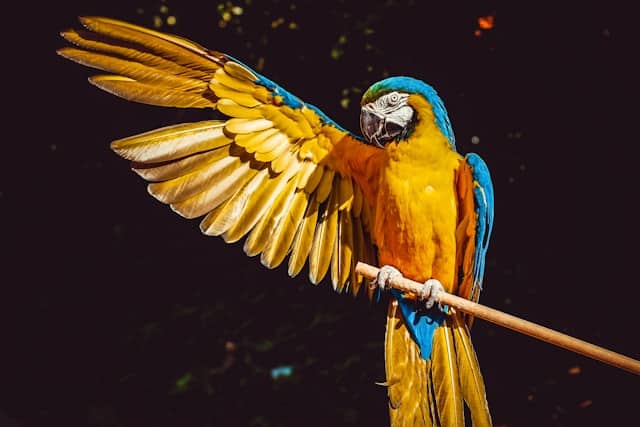How to Teach an African Grey Parrot to Imitate Specific Sounds or Phrases Accurately?

Parrots, particularly African Grey parrots, are well-known for their capacity to imitate human speech. They can learn to reproduce a wide variety of sounds and phrases, offering a fascinating perspective into the world of avian communication. It is no surprise, then, that teaching these birds to talk is a popular pastime for many pet owners. But how does one go about teaching a parrot to speak with precision and accuracy? This article provides a detailed walkthrough on how to effectively teach your African Grey parrot to imitate specific sounds or phrases.
Step 1: Building a Strong Bond with Your Parrot
The relationship between you and your bird plays a crucial role in the learning process. Building a strong bond with your African Grey parrot is the first and most fundamental step in teaching it to talk.
A lire en complément : What Are the Essential Nutrients for a Homemade Diet Tailored to a Sphynx Cat?
A strong bond fosters trust and encourages your parrot to engage more actively in the learning process. Spend quality time with your pet, familiarize it with your presence, and ensure it is comfortable around you. Regular interaction with your parrot will also provide ample opportunities for it to hear and learn from your speech.
Consistency and patience are vital in this process. Some birds may take longer to open up to their owners, but with consistent, gentle interaction, they will eventually become more comfortable and receptive.
A lire aussi : How to Properly Trim the Nails of a Holland Lop Rabbit Without Causing Stress?
Step 2: Establish a Learning Routine
Once a solid bond has been established, the next step is to institute a learning routine. Birds, like many other animals, thrive on routine. Regular and consistent teaching sessions can significantly enhance their ability to learn and imitate sounds or phrases.
Keep each session short but engaging, ideally not exceeding 15 minutes. You can choose to hold multiple sessions throughout the day. For optimal results, conduct your teaching sessions during the morning or early afternoon, as parrots tend to be more receptive during these hours.
In each session, focus on teaching one word or phrase at a time. Repetition is key in this process. Repeat the word or phrase multiple times, emphasizing clear pronunciation to enable your parrot to pick up the sounds accurately.
Step 3: Reinforcing Learning with Positive Reinforcement
Reinforcing learning with positive reinforcement is a highly effective way to encourage your parrot to speak. When your bird successfully imitates a sound or phrase, reward it immediately with a treat or its favorite food. This will associate the successful imitation with a positive outcome, encouraging your parrot to repeat the word or phrase more often.
While using treats, ensure not to overfeed your parrot as this can lead to health issues. The treats should be healthy and used sparingly as part of a balanced diet.
Remember, patience is essential. Don’t be discouraged if progress seems slow. Different parrots learn at different paces, and some may take longer to learn new words or phrases. Maintain a positive attitude and continue your teaching sessions with enthusiasm.
Step 4: Making Use of Technology
Technology, in particular, audio playback devices, can be a useful tool in teaching your parrot to talk. Record the word or phrase you want your parrot to learn and play it back repeatedly during your teaching sessions.
Ensure the sound quality of the recordings is clear and free from background noise. The volume should be at a comfortable level for your parrot – loud enough to be easily audible but not so loud as to startle or upset your bird.
You can also make use of online resources such as Wikihow and YouTube, which provide a wealth of information and tutorials on teaching parrots to talk. These resources often include visual aids such as images and videos, which can be beneficial in demonstrating teaching techniques.
Step 5: Ensuring the Well-being of Your Parrot
Last but not least, the overall well-being of your parrot plays a significant role in its ability to learn and imitate sounds or phrases. Ensure your bird is healthy, properly fed, and living in a comfortable and stimulating environment.
A stressed or sick bird is less likely to engage in learning activities. Regular vet check-ups and a balanced diet are crucial in maintaining the health of your African Grey parrot.
Remember, while teaching your parrot to talk can be an enjoyable and rewarding experience, it should never come at the expense of your bird’s overall well-being. Treat your parrot with care and respect, and you will find it can be an engaging and responsive companion in your teaching journey.
Step 6: Incorporating Visual Aids in Teaching
Teaching your African Grey parrot to talk can sometimes require more than just auditory cues. Often, the use of visual aids like images thumb can help stimulate your parrot’s interest and enhance its learning experience. Parrots are intelligent creatures with sharp eyesight and a good memory. They can associate words or phrases with specific objects, making visual aids a potent tool in training.
You can start by pairing the words or phrases you want your parrot to learn with corresponding images or objects. For instance, if you’re teaching it the word "Apple", show it an apple or a picture of one every time you utter the word. This will help the bird associate the word with the object, reinforcing its understanding and ultimately its imitation of the word.
You can find a variety of resources on the internet to aid in this process. Websites such as Wikihows offer in-depth guides and tips on how to effectively use visual aids when training parrots to talk. Other platforms like YouTube offer videos that demonstrate different teaching methods, which can be extremely beneficial in mastering the art of teaching your African Grey. Just remember when referencing these sites to look for the creativecommons org licenses, to ensure the materials you use are free to share and adapt under the creative commons license.
Step 7: Understanding Your Parrot’s Unique Personality
Parrots, like people, have unique personalities. Understanding the specific personality traits of your African Grey parrot can significantly enhance the teaching process. Some parrots may be more outgoing and receptive to learning, while others may be more reserved and take a bit longer to open up.
Observing your parrot’s behavior can give you insight into its personality. Take note of its reactions to different stimuli, its eating habits, and how it interacts with you and others. For instance, if your parrot is more active in the morning, schedule your teaching sessions during those hours for optimal results.
Also, remember that your parrot’s personality may affect the sounds or phrases it prefers to imitate. Some parrots may be more inclined to mimic sounds they find interesting or enjoyable. Experiment with different words and sounds and see which ones your parrot responds best to.
In conclusion, teaching your African Grey parrot to talk accurately is a process that requires time, patience, and understanding. Building a strong bond, establishing a learning routine, using positive reinforcement, making use of technology, ensuring the well-being of your parrot, incorporating visual aids, and understanding your parrot’s unique personality are all crucial steps in this process. Each parrot is unique and learning at its own pace. Remember to have fun during the teaching sessions and consider this process as a unique opportunity to deepen your relationship with your African Grey parrot. With consistent effort and dedication, you’ll soon hear your feathered friend repeating the sounds or phrases you’ve taught it, creating a fascinating and rewarding experience for both of you.
